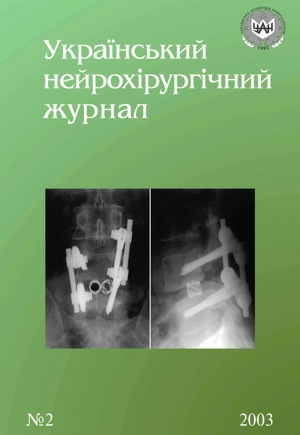The role of cerebral ischemia clinical forms in surgical treatment of patients with ruptured arterial aneurysms complicated by angiospasm
Keywords:
церебральний вазоспазм, артеріальна аневризма, ішеміяAbstract
We revealed data analyses of examination and surgical treatment of 256 patients with vasospasm after cerebral arterial aneurysm rupture that were operated in clinic during 2000–2002. We classify 3 forms of ischemia that define different methods of surgical treatment, based on clinical, neurological, instrumental examination.
References
Award I.A., Carter L.P., Spetzler R.F. et al. Clinical vasospasm after subarachnoid hemorrhage: response to hypervolemic hemodilution and arterial hypertension // Stroke. —1987. — V.18. — P.365–372.
Craen R.A., Gelb A.W., Eliaszw M. et al. Current anesthetic practices and use of brain protective therapies for cerebral aneurysm surgery at 41 North American centers // J. Neurosurg. Anesth. — 1994. — V.6. — P.303.
Davies K.R., Gelb A.W., Manninen P.M. et al. Cardiac function in aneurysmal subarachnoid hemorrhage: a study of electrocardiographic and echocardiographic abnormalities // Brit. J. Anaesth. — 1991. — V.67. — P.58–63.
Davis T.P., Alexander J., Lesch M. Electrocardiographic changes associated with acute cerebrovascular disease: a clinical review // Prog. Cardiovasc. Dis. — 1993. — V.36. — P.245–260.
Guglielmi G., Vinuela F., Dion J. et al. Etectrothrombosis of saccular aneurysms via endovascular approach // J. .Neurosurg. — 1991. — V.75. — P.8–14.
Kalfas I.H., Little J.R. Postoperative hemorrhage: a survey of 4992 intracranial procedures// Neurosurgery. — 1988. — V.23. — P.343–347.
Kassell N.F., Drake M.D. Timing of aneurysm surgery // Neurosurgery. — 1982. — V.10. — P.514–519.
Kassell N.F., Torner J.C., Haley C. et al. The international cooperative study on the timing of aneurysm surgery // J. Neurosurg. — 1990. — V.73. — P.18–36.
Kotapka M.J., Flamm S. Cerebral aneurysms: surgical consideration // Anesthesiology and neurosurgery/ Eds. J.E. Cottrell, D.S. Smith. – St. Louis: Mosby, 1994. — P.364–375.
Levy M.L., Gianotta S.L. Cardiac performance indices during hypervolemic therapy for cerebral vasospasm // J. Neurosurg. — 1991. — V.75. — P.27–31.
MacDonald R.L., Weir B.K.A., Runzer T.D. et al. Etiology of cerebral vasospasm //J. Neurosurg. — 1991. — V.75. — P.415–424.
Palmer J.D., Sparrow O.C., Lanotti F. Postoperative hematoma: a 5-year survey and identification of avoidable risk factors // Neurosurgery. — 1994. — V.35. — P.1061–1065.
Petruck K.C., West M., Mohr G. et al. Nimodipine treatment in poor-grade aneurysm patients // J. Neurosurg. — 1988. — V.68. — P.505–517.
Pickard J.D., Murray G.D., Illingworth R. et al. Effect of oral nimodipine on cerebral infarction and outcome after subarachnoid hemorrhage: British aneurysm nimodipine trial // Brit. Med. J. — 1989. — V.298. — P.636–642.
Shibuya M., Suzuki Y., Sugita K. et al. Effect of AT877 on cerebral vasospasm after aneurysmal subarachnoid hemorrhage // J. Neurosurg. — 1992. — V.76. — P.571–577.
Shimoda M., Oda S., Tsugane R. et al. Intracranial complications of hypervolemic therapy in patients with a delayed ischemic deficit attributed to vasospasm // J. Neurosurg. — 1993. — V.78. — P.423–429.
Solomon R.A., Fink M.E., Lennihan L. Early aneurysm surgery and prophylactic hypervolemic hypertensive therapy for the treatment of aneurysmal subarachnoid hemorrhage // Neurosurgery. — 1988. — V.23. — P.699–704.
Solomon R.A., Onesti S.T., Klebanoff L. Relationship between the timing of aneurysm surgery and the development of delaed cerebral ischemia // J. Neurosurg. — 1991. — V.75. — P.56–61.
Szabo M.D., Thai G., Lopez-Bresnahan M. et al. Exacerbation or unmasking of focal neurological deficits by sedative medication // Anesthesiology. — 1993. — V.79. — P. 216.
Tsementzis S.A., Hitchcock E.R. Outcome from orescue clipping of ruptured intracranial aneurysms during induction anesthesia and endotracheal intubation // J. Neurol. Neurosurg. Psychiat. — 1985. — V.48. — P.160–163.
Wijdicks E.F.M., Ropper A.H., Hunnicutt E.J. et al. Atrial natriuretic factor and salt wasting after aneurysmal subarachnoid hemorrhage // Stroke. — 1991. — V.22. — P.1519–1524.
Wijdicks E.F.M., Vermeulen M., Hijdra A. et al. Hyponatremia and cerebral infarction in patients with ruptured intracranial aneurysms: is fluid restriction harmful? // Ann. Neurol. — 1985. — V.17. — P.137 — 140.
Zabramski J.M., Spetzler R.F., Lee S. et al. Phase 1 trial of tissue plasminogen activator for prevention of vasospasm in patients with aneurysmal subarachnoid hemorrhage // J. Neurosurg. — 1991. — V.75. — P.189–196.
Downloads
How to Cite
Issue
Section
License
Copyright (c) 2003 O. A. Tsimeyko, V. V. Moroz, I. I. Skorokhoda

This work is licensed under a Creative Commons Attribution 4.0 International License.
Ukrainian Neurosurgical Journal abides by the CREATIVE COMMONS copyright rights and permissions for open access journals.
Authors, who are published in this Journal, agree to the following conditions:
1. The authors reserve the right to authorship of the work and pass the first publication right of this work to the Journal under the terms of Creative Commons Attribution License, which allows others to freely distribute the published research with the obligatory reference to the authors of the original work and the first publication of the work in this Journal.
2. The authors have the right to conclude separate supplement agreements that relate to non-exclusive work distribution in the form of which it has been published by the Journal (for example, to upload the work to the online storage of the Journal or publish it as part of a monograph), provided that the reference to the first publication of the work in this Journal is included.









